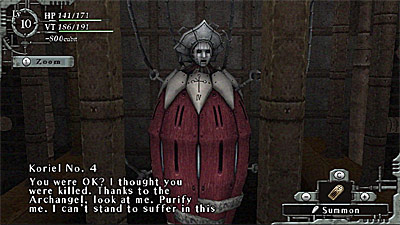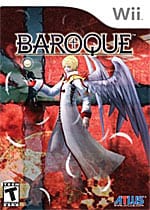For whatever reason, Nintendo’s recent consoles (that is, the GameCube and Wii) have never exactly been havens for RPGs. This doesn’t make a whole lot of sense to me, as the earlier consoles (particularly the SNES) as well as Nintendo’s handhelds have featured several fantastic games of that genre. Baroque is one of the first titles to explore the role-playing possibilities on Nintendo’s latest console and although it shows promise in several areas, it ultimately ends up being a shallow, disappointing game.

Baroque’s protagonist is a rather cryptic character who’s lost all memory of who he is. You’ve awakened in a mysterious town and given a mysterious message by a mysterious angel. There’s a lot of mystery around here, as you’ve probably noticed, but the game didn’t really go anywhere with this. Of course there’s a plot, and it resolves around the protagonist and his “quest for the truth,” but it’s rather shallow, and the promising storytelling elements revealed in the game’s opening never really come back. Your character has next-to-no personality, which is partly a problem with the game’s writing. In a word it’s disappointing, though I won’t say terrible because there are a few neat parts of the plot. Still, most of the characters you interact with are poorly done, and the dev team took a Zelda approach to the game in that the main character can’t speak. I hate to break it to them, but unless your main character is a timeless hero who’s instantly recognizable by 90 percent of the mass public, it’s not a good idea to make your character mute.
Baroque’s protagonist is a rather cryptic character who’s lost all memory of who he is. You’ve awakened in a mysterious town and given a mysterious message by a mysterious angel. There’s a lot of mystery around here, as you’ve probably noticed, but the game didn’t really go anywhere with this. Of course there’s a plot, and it resolves around the protagonist and his “quest for the truth,” but it’s rather shallow, and the promising storytelling elements revealed in the game’s opening never really come back. Your character has next-to-no personality, which is partly a problem with the game’s writing. In a word it’s disappointing, though I won’t say terrible because there are a few neat parts of the plot. Still, most of the characters you interact with are poorly done, and the dev team took a Zelda approach to the game in that the main character can’t speak. I hate to break it to them, but unless your main character is a timeless hero who’s instantly recognizable by 90 percent of the mass public, it’s not a good idea to make your character mute.

The bulk of this game is in its gameplay, as you’d likely expect from any standard RPG. Actually, Baroque isn’t really “standard” — it’s a dungeon crawler. I’ll go ahead and say it right now: if you’re into dungeon crawlers, then there’s still hope for a happy relationship between you and Baroque. But if you find them boring or generally don’t like them, then I’d strongly suggest that you stay away from this game.
The aforementioned angel directs you to Neuro Tower, and it’s here that you’ll be spending the vast majority of your time in this game. Neuro Tower holds all the secrets of your character, and it’s by progressing through this massive dungeon that you’ll ultimately unravel the mysteries of Baroque. The developers have pulled another really old trick out of their hat and created the game so that every time you enter Neuro Tower, you get a randomly generated dungeon — think back to Pokemon Mystery Dungeon on the DS and GBA. This would be a neat addition and extend the game’s play value if it weren’t for the fact that Baroque simply isn’t that fun of a game.

The biggest problem with Baroque stems from the game’s poor controls. There is no real Wii-specific control integration, which is to say we don’t get any quality motion sensitive controls. It’s fairly clear that Baroque was intended for the PS2 and then ported to the Wii because you’ll most likely play the entire game solely with the Wii’s sparse selection of buttons. Yes, there is some Wii remote control in the form of shaking the remote around nonsensically to perform attacks, but this gets very old and very boring in a matter of minutes. Think back to the combat in Twilight Princess, which had you shaking the remote in a few different ways to execute attacks. Well, Baroque’s control is even simpler: there’s only one attack, and as a result the game’s combat is going to get very stale. This is a problem I could have overlooked if it there’d been some depth to the system, but the fact is it’s generally hard to manage and as a result takes a lot of the fun out of the game. On the other hand, you can just use the more traditional control, but this doesn’t really prove to be a more satisfying control experience. Button mashers are not going to work on the Wii, but that’s something that Baroque’s dev team hasn’t figured out yet.
It’s a real pity that there are so many parts of Baroque that don’t work, because the title also features some innovations for the dungeon-crawling sub-genre. For example, rather than having a simple life meter of HP, you’ve got two life meters: one with your traditional HP and one with your vitality. Vitality is what matters, because as long as it’s full your HP meter will continue to refill itself. But if you let your vitality fall — and it will on its own just from walking around — then your HP will begin to decrease as well. What do you do? Kill stuff. Killing enemies will replenish your vitality, and in so doing adds a neat little strategy to the game. In most traditional RPGs, you avoid enemies when you’re low on health. But in Baroque, you do exactly the opposite — the game features no healing items, and this is a neat way to force you into combat and ensure that you don’t breeze through the tower. On the other hand, being forced to fight doesn’t sound so great when the controls you’ll use for fighting feel awkward and poorly conceived.

Aside from the control scheme, the hack-and-slash gameplay of Baroque is fairly fun, if repetitive. Combat is standard, and you’re already well-prepared if you’ve played such games as Final Fantasy XII on the PS2. You’ll find weapons, armor, and other accoutrements scattered throughout Neuro Tower which you can naturally use on your character. Additionally, you’ll even come into contact with what are called Parasites; these can then be bound with your weapons to create even more powerful items. Again, it’s a neat system that helps relieve the potential tedium of a dungeon crawler; however, it’s overshadowed by the fact that this game is generally not fun to play.
Baroque’s graphics are decent, but certainly don’t showcase what the Wii is fully capable of. It again becomes clear that this title was thought up as a PS2 title because the visuals of Baroque on the Wii match what I’d expect from a PS2 game. That said, the art direction is well-done, and the dark, death-themed surroundings mesh perfectly with the overall tone of the game. The music is also done well, featuring a quality soundtrack and (surprisingly) relatively good voice acting. Atlus is well-known for releasing polished games, and Baroque is no exception; it’s just too bad that the developers didn’t focus some of that attention on creating a better-playing game rather than a better-looking one.
Despite all of its problems, there are still a few redeeming aspects that hardcore hack-and-slash RPG fans may appreciate. It’s a really tough game with decent replay value, and while the controls are poorly done, there’s no denying the potential that Baroque has. It’s unfortunate that a game with this much promise turned out to be a rather poor title. Let’s just hope that Atlus and Sting have learned something from this outing and produce a much better RPG sometime in the near future. Until then, though, most people are going to want to avoid Baroque.
RATING OUT OF 5 RATING DESCRIPTION 3.3 Graphics
The atmosphere is nicely done as are some of the game’s cutscenes, but the fact that you’re essentially looking at PS2 visuals is a big drawback. 1.8 Control
I can safely say that this is the one aspect of the game that hurts Baroque the most. Shallow Wii remote integration and poorly mapped button controls make this game genuinely tough to play. 3.5 Music / Sound FX / Voice Acting
Atmospheric music blends nicely with the game’s dark theme, and the game also features some surprisingly impressive voice acting. 2.9
Play Value
A fairly uninteresting story along with badly written characters won’t encourage you to play this to the end. Still, fans of dungeon crawlers will likely find something here to like.
2.2 Overall Rating – Poor
Not an average. See Rating legend above for a final score breakdown.
Game Features:
